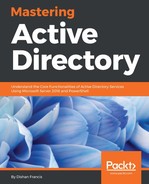When we talk about Active Directory, we refer to it as a single service, but AD DS is attached to many other components as well. DNS, group policies, and the SYSVOL folder replication are a few example. Each of these components need to operate well in order to run a healthy Active Directory environment. It doesn't come easy; it involves investment on resources, time, and skills. In the Active Directory service, the core values are centralized identity management, authentication, and authorization capabilities. All these extra components make it easy to archive its core values, but at same time, it also opens up risks such as dependencies and security. The failure or compromise of these components/services will make impact on the entire Active Directory infrastructure.
Microsoft Windows Core and Nano Servers also count as operating systems. These don't have fancy GUIs or sparkly applications running. But they are still doing the job of an operating system. It allows users to build them from scratch according to their requirements. It also increases the server up time (less updates), reliability, performance, and security. Soon after Microsoft released the first Active Directory version, IT engineers, application developers, IT professional start requesting a cut down version of AD DS with pure LDAP capabilities. They wanted to eliminate all these dependencies and management requirements, so they could focus on application development upon core AD functions. After Windows Server 2003, Microsoft released Active Directory Application Mode (ADAM), which allowed administrators to run cut down version of Active Directory without group policies, file replication, and so on. It can run on a desktop computer or a member server similar to any other Windows service. Simultaneously, it was providing all the core values of the Active Directory service. With Windows Server 2008, Microsoft renamed it Active Directory Lightweight Directory Services and allowed users to install the role using Server Manager. This version provided more control and visibility to administrators to deploy and manage LDS instances. This was continued with all the AD DS versions after that and was included in Windows Server 2016 too.
